HTC Titan Review
HTC Titan
Does the Titan clash with our mobile phone experts? Or is it a Kraken phone? That's enough puns…
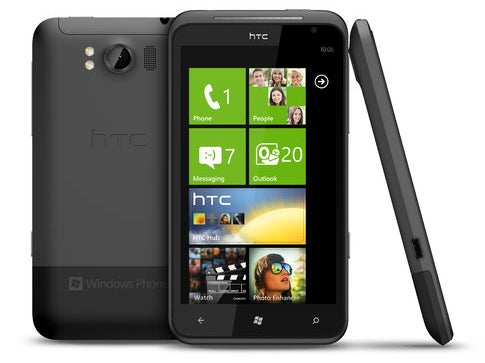
Verdict
Pros
- Good screen quality
- Super-fast performance
- Windows Phone is a joy to use
- Great camera
Cons
- Relatively low pixel density
- It's too big
- Windows Phone is restrictive
Key Specifications
- Review Price: £499.00
- 4.7in LCD WVGA screen
- Windows Phone 7 Mango software
- 9.9mm thickness
- 8 megapixel camera with f2.2 lens
gap between smartphones and tablets in a manner not seen since Dell’s 5in Streak.
It runs Windows Phone 7.5 Mango, has a 4.7in screen and HTC’s usual
superb build quality. What’s not to like? Aside from the fairly high
price and that its body works the phone into a niche, not a great deal.
Upon
first grasping the HTC Titan, you feel as though you’ve grabbed a
device made for someone else – someone bigger. Unless your hands are
quite dainty, it still fits comfortably between the butt of your palm
and fingertips, but it strains against the traditional definition of a
smartphone. This tech trend of larger screens on pocket devices can’t
continue that much longer.
For
its size, though, the HTC Titan fits remarkably comfortably into a jean
pocket. It’s only 9.9mm thick, so its cubic volume isn’t actually that
great.
The Titan’s styling continues the trend set by the HTC HD2 and HD7.
It’s black, simple and feels wonderfully strong. Most of the back is
made of metal, and the front covered with toughened glass. The design of
the back is rather deceptive, though. The seam a couple of centimetres
up from the bottom suggests there’s a small pull-off battery cover, as
seen in the HTC Salsa. But it’s a sham, because the backplate is full-length, released with the press of a little button on the Titan’s bottom.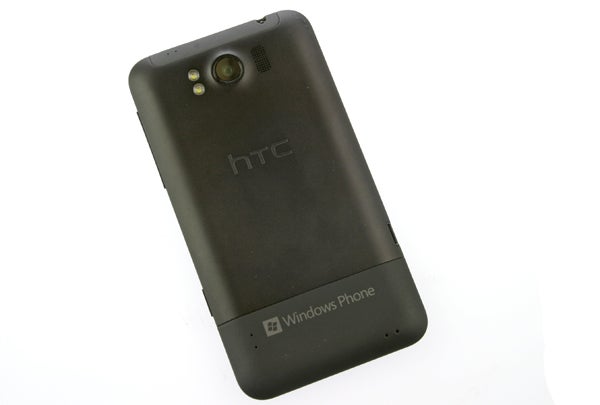
The
seam isn’t entirely meaningless, though. It shows where the metal of
the cover gives way to soft touch black plastic – there’s a cutaway of
this material at the top too, where the power button and 3.5mm headphone
jack live.
These touches don’t detract from the rather stern,
non-nonsense look of the HTC Titan. It’s hard not to be a little
impressed by the efficiency of the design – the phone’s front is 90 per
cent screen, leaving just a 15mm expanse at the bottom for the mandatory
touch sensitive Windows nav keys and a similar bit up top for the HTC
logo, the speaker to pipe out phone calls and the user-facing camera.
Missing
hardware features common to other smartphones, but absent from
virtually all current Windows phones, include a microSD card slot and
video output. There’s 16GB of internal memory built-in, but beyond that
you have to rely on the cloud to provide you with storage. The most
famous non-expandable smartphone series is, of course, Apple’s iPhone
range, which now offers models with up to 64GB of internal memory.
The
HTC Titan’s specs could be seen to fall behind in other ways too. This
is the time of the dual-core smartphone processor, featuring in the new
iPhone 4S and most top Android phones, but this phone has “only” a
1.5GHz single-core Snapdragon chip backed-up by an unremarkable 512MB
RAM. Looked at in isolation, this will be enough to put some off buying
the Titan when, at £500 SIM-free, it’s a top-end model. However, specs
mean little when considered out of context. That’s where Windows Phone
7.5 comes in…
Overuse of the term “iPhone killer” since Apple’s phone hit critical mass, following the release of the iPhone 3G in 2008, has robbed it of most potency and meaning – but it’s what Windows Phone 7 was originally intended as. Things haven’t quite worked out for Microsoft’s smartphone OS yet, but that doesn’t mean it isn’t rather brilliant.
One of the best things about the HTC Titan, compared to an Android or Symbian phone, is how wonderfully quick it is. The core user interface implements are hardware acceleration, letting it benefit from the handset’s graphics power all the time, rather than just when you’re trying to play a 3D game or HD-quality video. 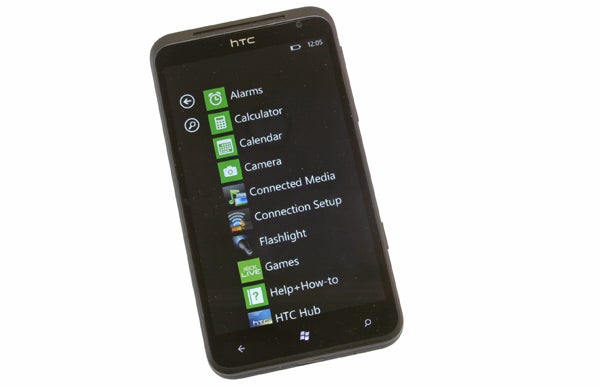
It’s intensely fast – not just in how quickly it responds to gestures on the super-responsive capacitive touchscreen, but in how fast menus are able to scroll and how snappily animated transitions are. This speed, combined with the aggressive styling of the system, makes using Windows Phone a very refreshing experience – like a pint of ice cold lime juice following days of drinking lukewarm, half-flat coke. Of course, not everyone likes lime juice and not everyone will love the unique look of the Windows Phone 7 interface.
The Titan’s home screen is a scroll of very sharp boxes Microsoft calls Live Tiles. These are shorcuts – some animated, some static – to apps, phone features and contacts. They’re fairly uniform in appearance, 90 per cent of them adhering to whatever colour scheme’s in place, but do helpfully show you updates. The Google Mail and Hotmail tiles show a number, for example, indicating how many new emails you have. It’s a notifications system and a home screen all in one, and while it’s not very flexible or customisable, like an Android home screen, it’s immensely easy to get on with.
You can move Live Tiles around, add and remove them, as well as changing their colour from a selection of 11 hues. Windows Phone is really into uniformity, and you can’t pick and choose – it’s strictly one colour at a time.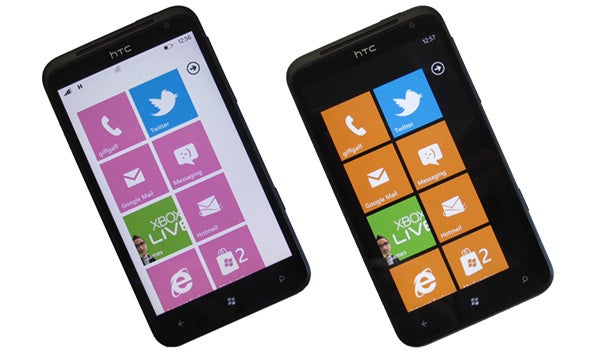
The look can be customised a bit. But only a bit.
At the launch of Windows Phone 7 in 2010, the system had all the rigid styling and speed it has now, but the recent Mango update filled-in the many feature holes that peppered the software. Including multitasking, which is simple and intuitive.
Hold down on the touch sensitive back soft key to bring up a row of snapshots of any running apps, which you then tap on to restore. There are still technical limitations when mulitasking with third-party apps, though. For example, skip to another app during an Angry Birds level and you’ll be directed to the initial load screen and main menu upon returning. It’s not quite the real deal yet.
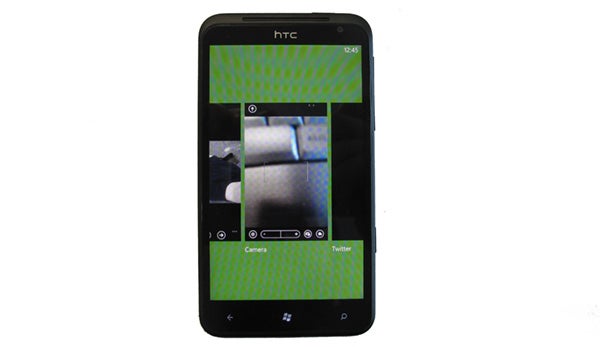
Multitasking feels good, but is technically a bit “meh” at the mo
Social networking integration has improved too. You can pre-tag photos of your friends before uploading them to Facebook, and clever messaging updates lets you carry on conversations with people over multiple platforms – IM and SMS, for example. The Mango update is an enrichment that has added depth to the Windows Phone OS, without dramatically changing the basic experience – you can now simply do more within its ornate walls.
Like an ornate, marble-walled museum, though, you can’t simply do what you like while inside. To transfer files, most crucially videos and MP3s, you have to use the proprietary Zune software – you’re not given access to the file system when you connect to a computer. Using the HTC Titan is a bit like living within a totalitarian regime. Accept its rules and marvel as everything ticks along nicely, the trains arrive on time and the streets are clean. If you like to go your own way, though, you may not find the Windows Phone life so accommodating.
This being a smartphone, these rules can be bent a little with the use of apps.
The HTC Titan’s official app store is Windows Marketplace. Just as heavily stylised as the rest of the Windows Phone operating system, it looks great and is very quick to navigate through.
If you don’t know exactly what you’re after, you may find it tricky to find what you want as discovery tools are lacking. Microsoft offers its “featured” selections and 17 categories, as well as “top”, “free” and “new” charts for each, but you’ll find a lot of scrolling is needed to dig up app gold.
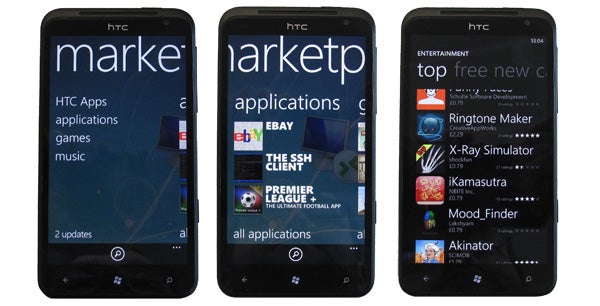
Quite how easy and quick flicking through lists of apps is on Windows Phone makes this less of an ordeal than it is on a 2.x Android phone, though, and each listing shows you its star rating and how may users have voted.
In late August 2011, Microsoft revealed that the Marketplace had 30,000 apps filling its shelves. To put this into context, the Android Market has more than 250,000 and Apple’s App Store over 500,000. In a straight comparison, the Windows Phone app market is tiny, but it does offer some bonuses over Android.
The Windows Phone styling has been carried over into many third-party apps, making them feel very well-integrated with the phone. Running the official Twitter app on the Titan, we find it – and several other top picks – strike a good balance between assimilating and offering their own flavour. 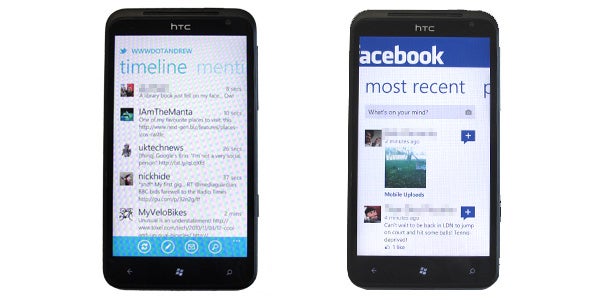
Facebook and Twitter apps are flavoured with WP7 sauce
There’s also Xbox Live gaming to consider. This is the glitzy end of the Windows Phone game scene. Each Xbox Live certified game reaches a decent level of production and overall quality – not every one is a guaranteed hit, but you won’t find utter dross here. And you can earn Xbox Achievement Points by playing, just like an Xbox 360 game. There are just 83 of these titles at the time of writing – hardly a massive collection.
If you’re willing to leave the safety of the Xbox Live interface, Windows Marketplace offers a less-regulated vanilla “games” category. This is where most smaller developers fire out their wares into no-man’s land of the Windows app store. And as most significant developers are Live-certified, the hit rate here is pretty low.
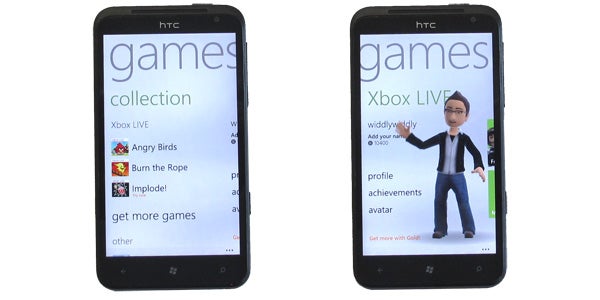
Many will be satisfied by the limited glossy library of Windows Phone 7 apps and games, but if you’re an apps or gaming nut, it’s not a patch on what the iPhone offers. The exciting development culture just isn’t here, primarily because the Windows Phone userbase is still small. A game new to Windows Phone might be a year or two old on iPhone and Android. Angry Birds only came out in July 2011, for heaven’s sake.
Good stuff? Yes. Timely releases? Not normally, no. This may change as the platform spreads its roots – something that’s bound to happen once Nokia’s Windows Phones arrive – but who knows how long this will take.
HTC offers a selection of its own apps too, but these haven’t been updated much since the first wave of Windows Phone 7 phones arrived a year ago. HTC Watch offers movie trailers and downloads, for example, but they’re all hopelessly out of date.
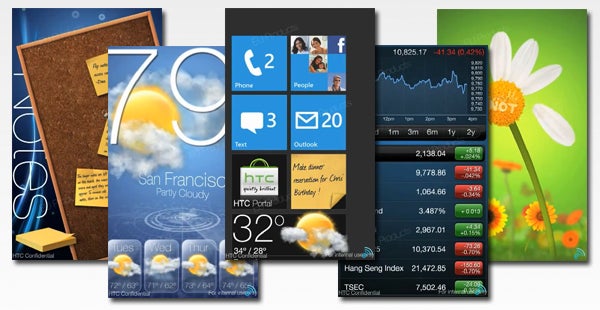
The rest don’t suffer from this neglect as much, mind. HTC Hub packs-in the clock and weather visuals from HTC Sense that were unable to be integrated into the Titan itself (Microsoft doesn’t allow direct changing of the interface by 3rd party manufacturers except Nokia), Connected Media hooks-up with any media files shared over your Wi-Fi network and Photo Enhancer fiddles with your images. Inoffensive stuff, certainly, but nothing that should influence whether you buy the phone or not.
The HTC Titan’s app potential is never going to match that of an iPhone 4S or Samsung Galaxy S2, but it can boast about its native Microsoft Office support. Other smartphones tend to rely on third-party developers for Word and Excel support, but Microsoft has done the job itself here.
You can edit and create Excel, Word and PowerPoint documents, and share them over SkyDrive. This is a free Microsoft Cloud service that gives you 25GB of storage for documents and photos. Of itself, this is not remarkable. HTC offers its own cloud storage for Android devices and Apple’s iCloud does pretty much the same thing (with a 5GB limit). However, the integration of Skydrive is particularly nice. It has some of that Apple-flavoured ease of use, and it makes SkyDrive worth using – rather than leaving ignored, as most tacked-on cloud services seem to be.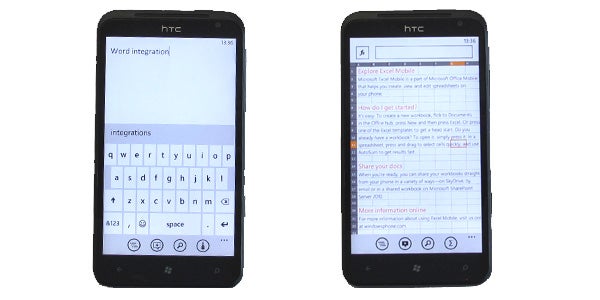
Even Windows Phone can’t make Excel fun, but it has a go
The Office app itself looks good too. This isn’t a powerhouse suite that gives you all the functionality of the desktop Microsoft Office, but getting away from this ideal is part of what Windows Phone 7 is about – and a big part of why it’s rather good. For reading and editing docx files or spreadsheets while on the train on the way to work, it’s great. This is one spot where the huge 4.7in screen of the HTC Titan comes in handy, making selecting cells in Excel a doddle.
Once you’re done, just save the file to SkyDrive and you’ll be able to pick it up from your computer at home or work, through the Windows Live ID used in the initial phone setup. An even handier utilisation of this cloud storage is for photos, but we’ll cover that later on in the camera section.
The HTC Titan’s 4.7in screen is both a strength and a weakness. It helps it stand out against other smartphones, but is – in our opinion – a bit too big. That leap from 4.3in to 4.7in tips oversized comfort into something else. Like that crucial divide between being “a bit cuddly” and “clinically obese”.
It may be natural step beyond the HTC HD7’s 4.3-incher, but we’d like to call time out to say that is enough is enough – this madness needs to stop. Pushing at the divide between smartphones and tablets is a curious obsession of manufacturers like HTC and Samsung, because they can’t really get over that one stays in your pocket and one stays in your bag. Make sure you have big hands before considering buying. We’ve just measured ours – anything much less than 19cm from wrist to fingertip is a no-go, folks. Get those rulers out.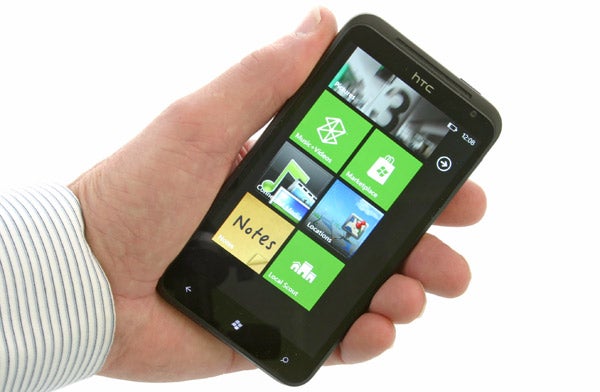
The quality of the display is good. The HTC Titan uses an S-LCD panel, which is what HTC switched to after supplies (and presumably the cost) of AMOLED panels became prohibitive in 2010. It does a good job too, offering vivid colour, decent contrast and excellent maximum brightness. Performance isn’t as flawless as an AMOLED panel, though.
In dark conditions, that it uses a standard backlight becomes clear, with plenty of luminescence – with an AMOLED blacks stay black whether you’re in a dark or light environment. There’s also a tiny bit of blue hue to the screen when viewed at an angle. Altogether, though, it’s a good panel.
However, the screen resolution isn’t too hot. It has 800×480 pixels to work with, which isn’t much for such a large screen. 384,000 pixels may sound like a lot, but it’s a paltry figure compared with the 921,600 pixels of the Samsung Galaxy Prime, which has a similar-size 4.65in screen. This probably isn’t HTC’s fault, as every Windows Phone 7 device so far hasn’t strayed beyond 854×480 resolution – and Microsoft has pretty strict hardware guidelines.

The low-ish DPI screen makes zoomed-out text look blocky
Does it scupper the phone in real-life usage? For the most part, no. The Windows UI has been so carefully honed that the relatively-lowly 198dpi pixel density doesn’t look at all blocky apart from when you skip to the web browser. Zoom out and text starts to looks a little blocky – with a higher pixel density screen the text would remain sharp – reducing the browsing bonuses of the larger display.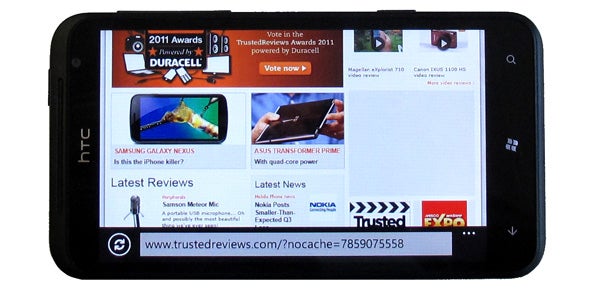
The browser software is great. We recommend avoiding Internet Explorer on a desktop computer, but it does the job admirably on a smartphone. The web address bar is down the bottom, so you don’t have to stretch to reach the top of the screen to tap in a web address – important in a phone so big. Windows Phone 7.5’s fab virtual keyboard makes typing away very accurate too, although as the Titan is so wide, two-handed typing is recommended in both landscape and portrait orientations.
Once again, our quibbles boil down to one main thing – the HTC Titan is just a bit too big.
The HTC Titan offers an 8-megapixel camera with a dual-LED flash. Although there are 12-megapixel cameras out there, this spec equals the current top camera phones – the Sony Ericsson Xperia Arc S and iPhone 4S. 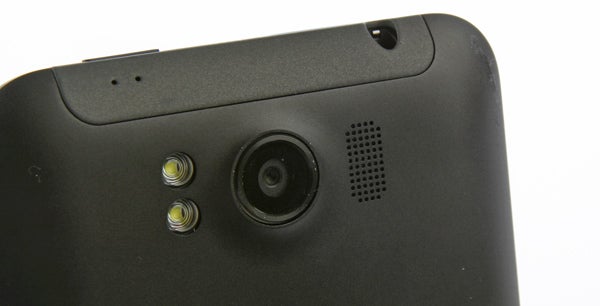
It’s a tough crowd to be a part of, but the HTC Titan performs very well. In good lighting, sharpness is good. There’s significant evidence of processing designed to make photos “pop” that little bit more, while tiny detail is fringed a little by the effects of sharpening and JPEG compression, but quality is nonetheless more than acceptable. Colour is perhaps a little too vibrant but not to the point where shots don’t look lifelike. This phone can just about produce shots worth printing out, not just leaving to rot on Facebook’s servers.
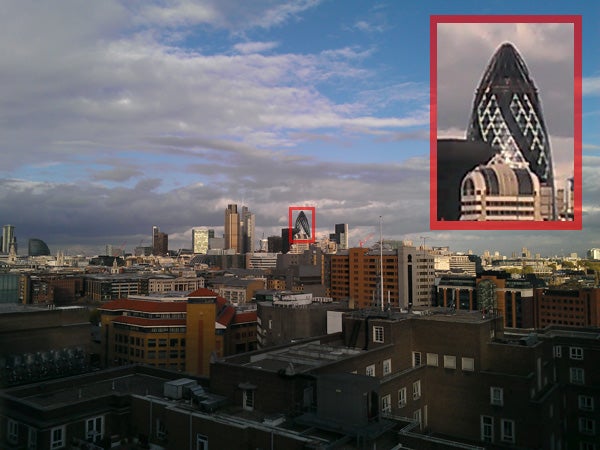
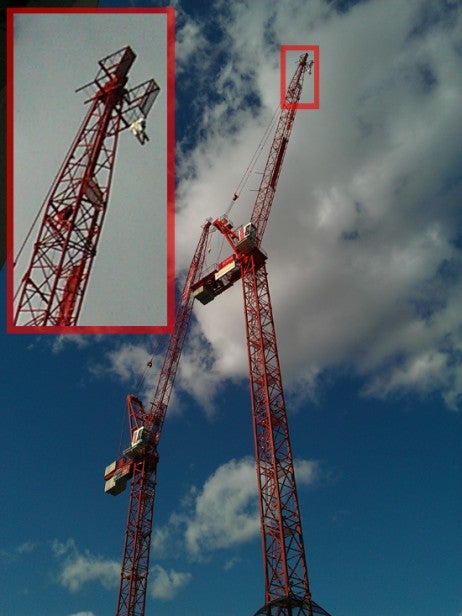
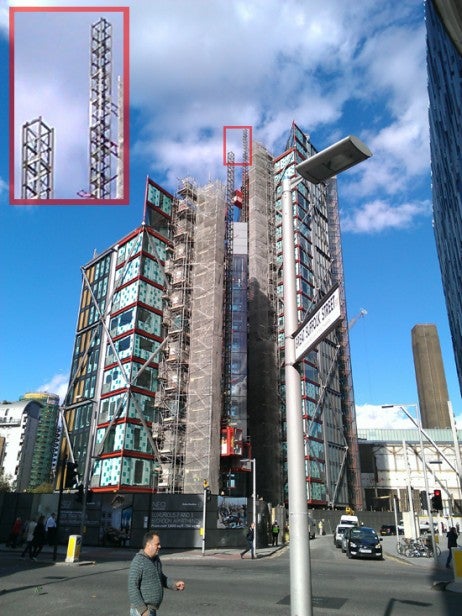
In lower light conditions, images predictably become a lot noisier, but the vibrancy is still there. As you can see from this street scene (well, car park scene), colours retain potency even as the sun disappears. The HTC Titan has over-egged the colour at but, but not disastrously so – this was taken a sunset, not night time, so the sky should be blue, not black.
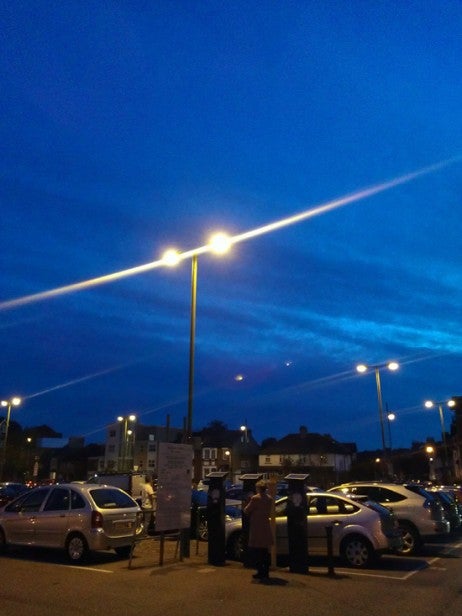
Weird light effect aside, it handles low-light conditions OK
Just as important as image quality, when considering a smartphone camera, is how easy it take quick, in-focus snaps. The HTC Titan excels here. Just a single tap on your subject sets the white balance, exposure compensation, attains a good focus and takes a snap. The whole process takes around a second – which feels very quick – and the focusing system is very reliable. We only took one real stinker of a photo in our time with the Titan.
The maximum resolution for video is 720p, which is unremarkable when the iPhone 4S and Samsung Galaxy Nexus can grab full HD 1080p clips, but it does have continuous focusing and stereo audio. The former is arguably more important than 1080p capture, making this a versatile little video device.
Control over camera settings when capturing stills is pretty good too. There are the usual array of scene modes and effects, plus panorama, face detection and burst modes, and settings for white balance, brightness, contrast, saturation, metering, sharpness and – the stand-out – ISO (with 100, 200, 400, 800 and Auto options). For all the sample shots above, these were set to either Normal or Auto, as available.
Within the Titan’s settings menu, you can set the phone to upload any pictures you take to the SkyDrive “cloud”. However, this significantly degrades quality, in order to cut down the file size for easier transfer. There’s no way to change this so full-res photos are uploaded. Pesky Windows Phone 7.5 (and 7) also shrinks your photos down when you try and email them, making – you guessed it – Zune software sync the only way to get full-res photos off your phone. If, like us, you want to see what the 8-megapixel sensor is really capable of, this quickly becomes a royal pain.
Using the HTC Titan as a portable video player or MP3 player is similarly afflicted. Transferring any files requires the Zune software. If you can find it within yourself to embrace the Zune software as your main music and movies organiser, you’ll be laughing – it even lets you sync over Wi-Fi – but we imagine many of you who have been using the same music software suite for years won’t make the transition joyfully. If you already use the Zune software, do give us a shout in the comments. In our mind’s eye there are not more than ten of you out there.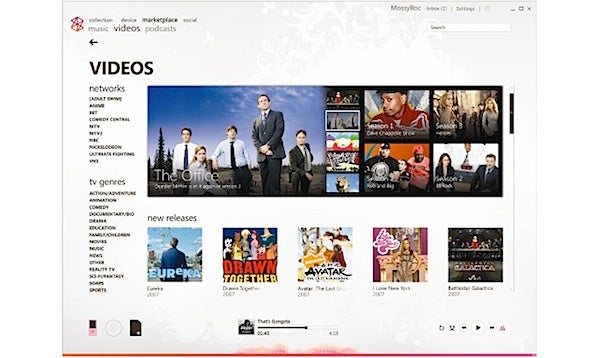
If you want to be the Titan’s lover, you gotta get with its friend, Zune
Give in and make the leap, and you’ll find the HTC Titan an enjoyable media partner. Its interface for music and video is just as swish as the rest of Windows Phone 7.5, and the 16GB of internal memory is enough for around 150 albums or 10 movies. Codec support is thoroughly unimpressive, though, so if you have anything bordering on an esoteric music or film collection – file format wise – you’ll have to convert. In fact, virtually the vast majority of videos downloaded from the net will need to be converted. And that’s no fun.
We’ve covered the apps, the camera, the interface – but neglected whether the HTC Titan can actually make phone calls well. It can. The maximum call volume is very good, and voices sound clear and robust. It’s not brittle or reedy as you’ll hear in some other smartphones.
There’s also active noise cancellation – although this benefits the person you’re calling rather than yourself. A pinhole microphone sits up on the top of the Titan, monitoring ambient noise. The phone then fiddles with the sound reaped from the main mic – the one that listens to you yammering on – and removes this ambient noise from it, by applying an inverse wave. It’ll come in handy if you’re talking to someone outside on a windy day, or by a motorway. 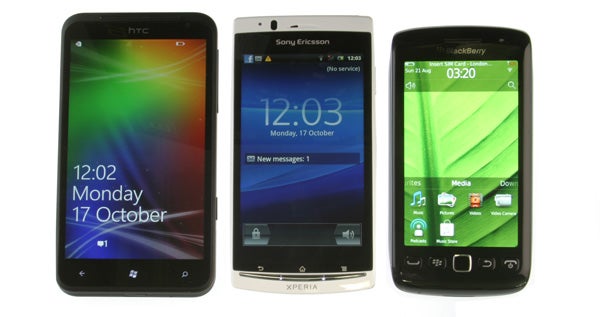
We’ve criticised the HTC Titan several times for being so big, but surprisingly the main cause of this size, the screen, doesn’t kill battery life. The phone uses a 1600mAh battery that will last a good day and a half off a full charge, with frequent email checks, a bit of game-playing and a few sessions with a handful of choice apps. Yes, you’ll have to charge it every day to be sure – unless you’re a very casual smartphone user – but it betters many Android smartphones.
An inevitable comparison with Android phones is one of the HTC Titan’s big issues. Similarly-priced phones like the Samsung Galaxy SII and Motorola Atrix offer either a faster processor or higher-resolution screen. High pixel density screens are all the rage at the moment, and the 4.7-incher of the Titan only emphasises how “not high” its pixel density is. But, just as the 1.5GHz processor makes light work of Windows Phone 7.5, the interface still looks fab on the sub-200dpi 800×480 screen. Unless you make these things issues for the sake of the specs, they won’t become problems.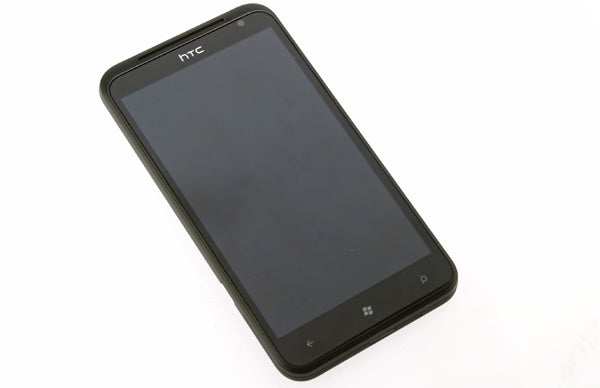
However, after living with the Titan for a while now, we can’t get over that it still feels a bit too big. It’s not a fault of the design as such – it’s about as small as you can reasonably expect a 4.7in phone to be – but we’d advise you to stop and think rather than barrelling in, wallet open, under the assumption that bigger is better.
At £499, or free on a £30 or so contract, it’s a top-end phone, so there’s plenty of worthy competition. And unless you’re particularly keen on its high-spec camera, the last generation of Windows Phone handsets are Mango compatible, run like a dream and are available for £100 less. The most important development in Windows Phone handsets is the software, not the leaps this second-wave device makes in specification.
Verdict
The HTC Titan reminds us of quite how enjoyable Windows Phone is to use. It’s quick, intuitive and stylish. However, this phone also makes us realise quite how silly the trend for ever-expanding smartphone screens is. This is undoubtedly a great phone, but for most people it’ll be just that bit too big.
Have giant-sized hands? There’s very little not to like about this phone. Its screen and processor can’t match the specs of top-end rivals like the iPhone 4S and Samsung Galaxy Prime, but when running Windows Phone, these things just don’t matter. It looks and feels great throughout.
How we test phones
We test every mobile phone we review thoroughly. We use industry standard tests to compare features properly and we use the phone as our main device over the review period. We’ll always tell you what we find and we never, ever, accept money to review a product.
Trusted Score
Score in detail
-
Performance 9
-
Design 8
-
Value 8
-
Features 7
General
| Operating System | Windows Phone |
| Height (Millimeter) | 131.5mm |
| Width (Millimeter) | 70.7mm |
| Depth (Millimeter) | 9.9mm |
| Weight (Gram) | 0.16g |
| Available Colours | Black |
Display
| Screen Size (inches) (Inch) | 4.7in |
| Screen Resolution | 480x800 |
| Touchscreen | Yes |
Storage
| Internal Storage (Gigabyte) | 8GB |
| Camera (Megapixel) | 8.0 Megapixel |
| Front Facing Camera (Megapixel) | 1.3 Megapixel |
| Camera Flash | Dual LED |
Connectivity
| Bluetooth | Yes |
| WiFi | Yes |
| 3G/4G | Yes |
| 3.5mm Headphone Jack | Yes |
| Charging/Computer Connection | Yes |
Processor and Internal Specs
| CPU | 1.5GHz |
Misc
| App Store | Yes |
| GPS | Yes |


